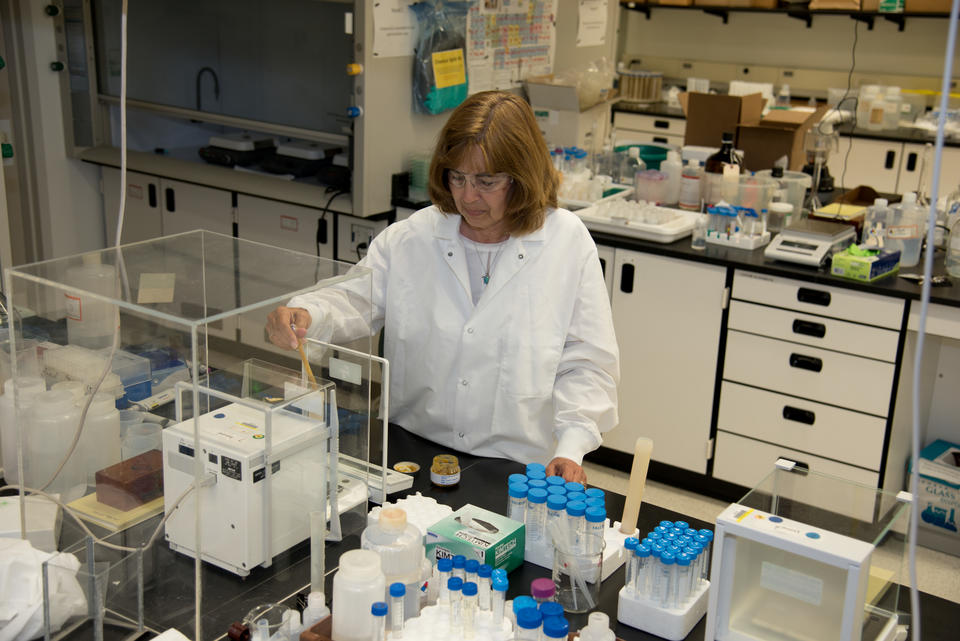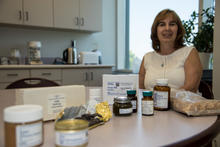Taking Measure
Just a Standard Blog

NIST scientist Laura Wood works on SRM 2383 Baby Food Composite
As the seasoned mom of three grown children, I’m happy to say that they all made it through babyhood without any major health issues. While I worked as an analytical chemist at NIST during their baby years, I wasn’t working on reference materials for measuring nutrients in the foods that they ate or, even worse to think about, toxic elements in them.
I mention this because recently I was asked about an article that reported traces of lead had been found in baby food. While feeding my babies I just assumed, and expected, the baby food they were eating was safe for them. After all, I thought, they are just babies, and we live in the land of milk and honey. Don’t we? Of course we do, and of course their baby food was safe for them, wasn’t it? And what about that milk and honey? Were those safe too?
Standard Reference Food
For the past 10 years, I have been producing and analyzing Standard Reference Materials (SRMs) for foods. Food SRMs are typical foods you might buy at the grocery store: chocolate, spinach, peanut butter, and yes, baby food. What makes these SRMs different from “normal” food is the fact that they have been carefully tested to measure the exact amounts of minerals, vitamins, fats, proteins, and other nutrients in them. When manufacturers analyze our SRMs and get the right answer, i.e., the same answer we got, chances are good that they got the right answer when they were testing their own products and can be confident about the values they publish on their nutrition labels.
Now, you may have noticed that lead, arsenic, cadmium, and mercury are not listed on the food nutrition labels. So how do we know if there are toxic elements in the foods we eat? Besides putting nutrition facts on the labels of the foods they sell, food manufacturers must also follow safety guidelines. In the U.S., the Food and Drug Administration (FDA) sets the guidelines, or limits, for the levels of toxic elements permitted in foods. Even though they don’t list toxic elements on their labels, manufacturers still need to make sure their products are safe, and so they use NIST SRMs to do this as well.
You’re probably thinking, wait a minute, it’s okay to have toxic elements in our food? Well, it’s complicated. We certainly don’t want these toxic elements in our food, and food manufacturers and regulators do everything they can to minimize them, but the truth is that if you want to eat, you will likely be eating some (probably tiny) amount of toxic elements with that food.
One reason for this is that plants absorb elements, both good and bad, from the soil they are grown in. The toxic elements may be naturally occurring in the soil or may have come from human activity such as mining or waste disposal. Regardless of their source, when we eat those plants, or when we eat the animals that ate the plants, we eat the toxic elements as well. When plants are grown in heavily contaminated soils, or foods are contaminated during preparation or packaging, the toxic elements become a real problem. Companies do everything they can to keep their products safe—if foods with unsafe levels of toxic elements end up being sold to the public, companies recall them. Additionally, the FDA has the authority to keep contaminated foods from entering the U.S.
Toxic Traces in Baby Food

NIST SRM 2383 Baby Food Composite is a weird combination of foods and not actually a real baby food. This SRM was specifically designed to contain certain amounts of vitamins and elements so that it could be used for nutrition labeling. We did try to measure some toxic elements, though. When this material was first developed, we measured both arsenic and mercury. We found that mercury was undetectable and the arsenic concentration was only 3 nanograms per gram, or 3 parts per billion (ppb). That means if you ate half a jar of the SRM, about 35 grams, you’d be eating 0.000 001 05 grams of arsenic—a speck about 600 times smaller than a single grain of sugar.
The NIST baby food SRM had never been tested for lead and cadmium, so I wanted to know if those elements were in there too. A quick test found about 12 ppb of lead and less than 19 ppb of cadmium, lower than what I can reliably measure. Right now, I’m unable to tell how much lower.
Should we believe these very, very small numbers? I mentioned that mercury could not be detected at all and that there was less than 19 ppb cadmium. We cannot say exactly how much cadmium is in the baby food since it is below what we call the limit of quantification—the level at which we’re confident that our measurements are accurate. Generally, we can measure things reliably at levels that are three or four times higher than the minimum we can detect. For lead, the level where we know the measurements are accurate is even lower than cadmium, about 2 ppb. Twenty-five years ago, when my kids were babies, the state-of-the-art equipment that we used was about a hundred times less sensitive than what we have today.
Measured to the Limit
The fact that we couldn’t detect lead in baby food 25 years ago doesn’t mean that it wasn’t there. It may have always been there, but our instruments couldn’t see it. Now that our tests and equipment have improved, we know it’s there, and we can use that knowledge to try to improve the safety and quality of our food supply. When we cannot see an element at all in a food we say it is below the detection limit. Mercury is below the detection limit in the NIST SRM 2383 Baby Food Composite, but we can never say it is not in there—there may just be too little to see. With new technology, elements can be detected at lower and lower levels, but we need to be careful that what we’re measuring is really in the food we’re testing and not from a source of contamination in the laboratory.
So, knowing what I know now, would I still have fed baby food to my kids? In short, yes. I work closely with food manufacturers and scientists. I know that the manufacturers of baby food, and all food, have expert chemists who work hard to make sure those foods are as safe as they possibly can be for my kids—and for you.
And they use NIST’s food SRMs to help them do this!
About the author
Related Posts
Comments
- Reply





